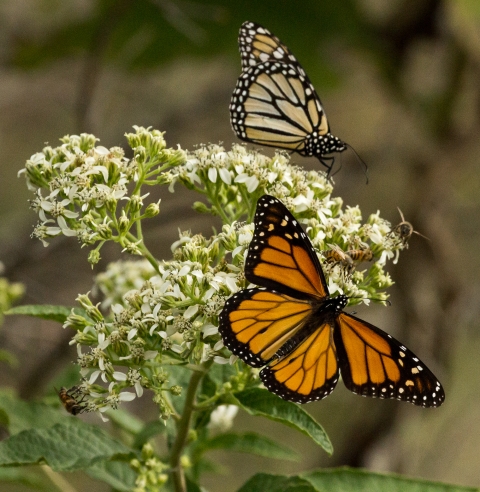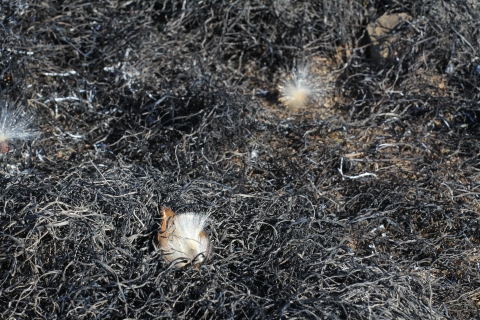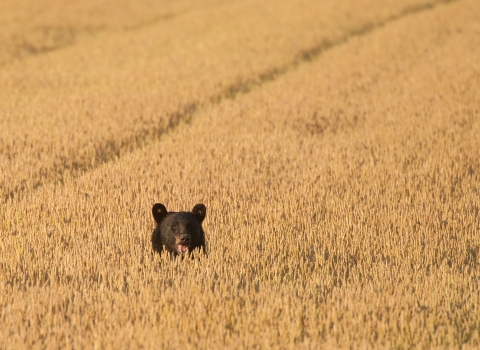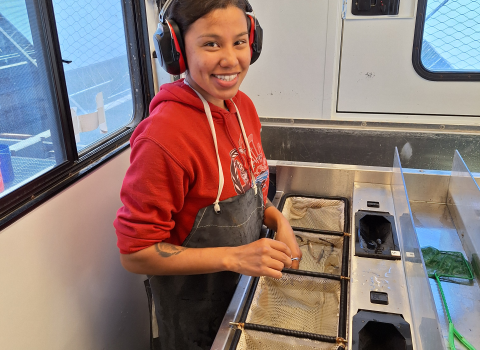Since March 2018, fire management program staff at Balcones Canyonlands National Wildlife Refuge has implemented a series of prescribed fires as part of a special project to enhance habitat for monarch butterflies and other native pollinators on private lands in Texas. The project has enhanced 7,200 acres of pollinator habitat by working with private landowners to improve habitat and increase milkweed and nectar plant availability through the careful application of prescribed fire to important areas. Milkweed is vital for monarch breeding and nectar plants support the spring and fall migrations.
The annual migration cycle of the monarch butterfly is as unique as the diversity of the landscapes it travels. Beginning and ending in the oyamel fir forest of Mexico, the monarch migration relies on a relatively narrow corridor of habitat through the Texas rangelands. The first generation of their yearly trek brings them into the blossoming spring of wildflowers and milkweed between the Rio Grande and the Red River to breed and recharge from the flowers nectars. As the fourth and fifth generations return through the same Texas range, they resupply from the ample abundance of pollinator plants in late summer and early fall.
The initial step of the Enhancing Monarch Habitat on Private Lands in Texas project called for the identification of private lands that met or exceeded the criteria for improving monarch habitat. Approximately 83% of Texas lands are privately owned and rely on ranching and agricultural practices to provide economic and environmental benefit. Increasing the health of privately owned rangelands can have rewards for wildlife and surrounding ecosystems, and many landowners use prescribed fire to remove invasive species invasive species
An invasive species is any plant or animal that has spread or been introduced into a new area where they are, or could, cause harm to the environment, economy, or human, animal, or plant health. Their unwelcome presence can destroy ecosystems and cost millions of dollars.
Learn more about invasive species and enhance species habitat. This, in turn, benefits monarch butterflies, as well as other native pollinators.
Our fire program at Balcones Canyonlands National Wildlife Refuge routinely uses prescribed fire and wildfire management at refuges in Texas and nationwide. For the monarch project, the fire management staff leveraged their experience in planning and implementation of prescribed fire on refuge lands to provide landowners with valuable insight of the benefits of continued prescribed fire projects. Expanding beyond the refuge borders and engaging local officials and land managers on the benefit of safely managed fire has proved to be a catalyst for building trust among the local communities and fostering a community of practice.
Our Partners for Fish and Wildlife program staff has worked closely with participating landowners to develop supporting practices like prescribed grazing and grazing deferments, brush management, and supplemental seeding of native plants. Partners biologists in our Austin Ecological Services Field Office and the refuge’s fire program staff have supported prescribed fire projects on private lands across Texas for over a decade.
Beyond increasing the quality of habitat through prescribed burns, the project has made long-lasting contributions to the prescribed fire culture within the monarch migration corridor. To date, the project has completed 13 prescribed fires in six different counties, averaging 555 acres per treatment for a total of 7,217 acres. In addition to enhancing habitat for monarch butterflies and native pollinators, these burns helped restore watersheds and aquifer recharge zones for several critical watersheds within the migration corridor by promoting healthy native grasslands.
Burning on private lands involves cooperative agreements developed by our Partners staff, who work with landowners to improve fish and wildlife habitat on privately owned lands. Much of the nation’s fish and wildlife depends on private landowners. Providing more high-quality habitat helps maintain healthy populations of fish, wildlife, and plants, as wells as insects like pollinators. The Partners program is a voluntary, incentive-based program that provides technical and financial assistance directly to private landowners to restore and conserve fish and wildlife habitat across the country.
Partnerships are key to accomplishing this type of work. We team up with private conservation organizations, state and federal agencies, Tribes. These groups share funding, materials, equipment, labor, and expertise with the landowner to meet both the landowner’s restoration goals and the agency’s conservation mission.
The National Fish and Wildlife Foundation funds prescribed burns executed under our Partners program, and these burns require coordination with landowners, neighbors, local and state officials, and local fire departments. For this project, we’ve also partnered with Oaks and Prairies Joint Venture, National Resource Conservation Service, Texas A&M University Forest Service, Texas A&M University AgriLife Extension, and the Texas Parks and Wildlife Department.








